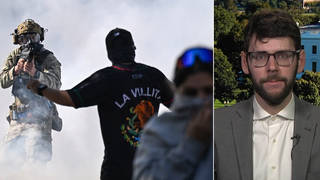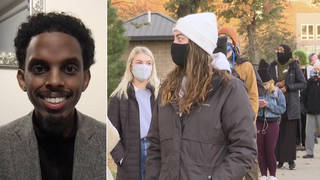
Topics
Guests
- Matthieu Aikinsjournalist based in Kabul who joins us now from Halifax, Nova Scotia. Aikins is currently a Schell fellow at The Nation Institute. His recent article for Rolling Stone magazine is “Afghanistan: The Making of a Narco State.”
In the 13 years since the United States invaded Afghanistan in 2001, the country’s opium production has doubled, now accounting for about 90 percent of the world’s supply. To learn more, we are joined by Matthieu Aikins, a Kabul-based journalist whose latest report for Rolling Stone magazine explores Afghanistan’s heroin boom. “What has happened in Afghanistan over the last 13 years has been the flourishing of a narco-state that is really without any parallel in history,” Aikins says. “This is something that is extraordinary, that is catastrophic, that has grave danger for the future and yet there has been virtually no discussion of in recent years.”
Transcript
AMY GOODMAN: As the U.S.-led coalition in Afghanistan officially concluded its combat mission Sunday, 13 years after it started in 2001, ending the longest war in U.S. history, we continue speaking with Matt Aikins, a journalist usually based in Kabul. He’s speaking to us by Democracy Now! video stream from Halifax, Nova Scotia, in Canada. His recent article for Rolling Stone magazine is headlined “Afghanistan: The Making of a Narco State.” Why don’t you lay out for us what has happened in Afghanistan around the growing of heroin, Matt Aikins?
MATTHIEU AIKINS: Sure. Well, today Afghanistan produces twice as much opium as it did in the year 2000. And this spring I traveled to Helmand province in southern Afghanistan to witness what would be the largest harvest of opium in Afghanistan’s history. It’s a record year. And all over the south, east, west and north of the country, hundreds of thousands of people were taking part in this labor-intensive opium harvest. So, what has happened in Afghanistan over the last 13 years has been the flourishing of a narco-state that really is without any parallel in history. It accounts for 15 percent of the GDP, which is more than double what cocaine accounted for at the height of Escobar-era Colombia. So, this is something that’s extraordinary, that’s catastrophic, that has grave danger for the future, and yet there’s been virtually no discussion of in recent years.
AMY GOODMAN: Who’s growing it? Who’s profiting?
MATTHIEU AIKINS: Everyone is growing it. Everyone is profiting. It touches all levels of Afghan society, both sides of the conflict, the Taliban and the government. The Taliban is definitely involved. They profit by taxing the trade, by taxing growers in their areas. But the government is even more involved. Government-linked officials are believed to earn an even higher piece of revenue from the opium trade.
AMY GOODMAN: Talk more about the involvement of the Afghanistan government. Again, quite an amazing fact that Afghanistan provides 90 percent of the opium in the world.
MATTHIEU AIKINS: Well, what’s important to remember is the history here. So, after 2001, the U.S., in its quest for vengeance against the Taliban and al-Qaeda, partnered with the very warlords whose criminality and human rights abuses had created the conditions that led to the rise of the Taliban in the first place. And in many cases, these are the same individuals who were responsible for bringing large-scale opium cultivation to Afghanistan during the war against the Soviets. When they were backed by the CIA and Pakistan’s military, they became involved in heroin trafficking and opium production.
So, for example, in Helmand, which is the most—the largest opium-producing province in Afghanistan, they brought back a member of the Akhundzada family. Karzai appointed him as governor. He was a key ally of the U.S. special forces there. And this is the same guy who had been responsible for bringing opium production to Afghanistan. So, the reason that opium has flourished in Afghanistan is because we have brought in, supported, tolerated figures who are involved in very grave criminality and in human rights abuses and in torture. And we’ve done this because it’s been deemed militarily expedient. The generals and diplomats have decided that to pursue these, you know, narrow goals of defeating the Taliban, we needed some—to support these criminals.
AMY GOODMAN: Talk about Marjah more. Talk about its going from poppy-free to what it is today.
MATTHIEU AIKINS: Yes. Well, you probably remember Marjah was the site of one of the largest battles of the war, the Battle of Marjah, where the Marines air-assaulted into this stretch of irrigated canal land, that had actually, in a rather ironic twist of history, been built by a USAID-funded project in the 1950s and ’60s as part of the Cold War rivalry with the Soviets. They built this huge canal-irrigated zone west of Helmand that brought, you know, agriculture to the desert. And that was eventually turned into a center for poppy cultivation and a bastion of the Taliban, you know, by the mid-2000s.
So the Marines air-assaulted in. There was this very televised battle. They threw the Taliban out. And for a few years, the area was indeed poppy-free. But since then, as the Marines have left, as the Afghan government has become very distracted by the elections, farmers there had taken to poppy cultivation again. It was part of a general trend across the country that what small gains had been made in reducing poppy cultivation were being reversed, because they had largely been driven by short-term incentives.
And so, I went to Marjah and hung out with these farmers and saw their opium harvest, and it was really remarkable, because, you know, I was sitting in a living room with this guy, and he brings out a basketball-sized lump of opium. And I asked him how much he was thinking he was going to sell this for. He said, you know, he hoped to sell it for $600. And I asked him, you know, “Do you know how much this will be worth on the streets of Europe?” And he said he didn’t. So I did a quick calculation in my head, and it worked out to over $100,000, if it was converted into heroin and sold by the gram. So, you know, $100,000 sitting on the floor of a guy without plumbing or electricity really gives you a sense of how Afghanistan, in fact, is just at one end of this vast global economy that is the international drug trade.
AMY GOODMAN: You also write about the history of U.S. involvement and CIA involvement with drug traffickers in Afghanistan. Can you talk about that?
MATTHIEU AIKINS: Yeah, well, you know, the CIA’s dirty wars that it fought in Afghanistan involved patronizing mujahideen commanders who in many cases were directly involved in the narcotics trade, people like Gulbuddin Hekmatyar, who was responsible for the flourishing heroin laboratory seen in Pakistani tribal areas in the 1980s; Mullah Nasim Akhundzada, who was—I already mentioned—a major drug baron in southwestern Afghanistan. These are all people who’d receive U.S.-supplied weaponry and funding.
AMY GOODMAN: And you note that the U.N. has estimated the Taliban makes hundreds of millions of dollars from taxing opium and other illicit activities. But in the summer of 2000, the country’s fundamentalist leaders actually announced a total ban on opium cultivation. What changed?
MATTHIEU AIKINS: Well, you know, the Taliban’s decision to ban poppy cultivation in 2000, which was actually remarkably successful—the only poppy that was really cultivated in the country that year was in the corner of the country still controlled by the Northern Alliance, who later became our allies. So, there’s still a lot of debate as to why the Taliban made that decision. Probably it was just a rash one based on ideological beliefs—they were against opium as an intoxicant, being forbidden in Islam—one that where they were seeking to break their international isolation and get some desperately needed development aid. But in any case, since the invasion, you know, since the war, the Taliban has found it expedient to become involved in not just drug trafficking but all sorts of illicit activities—marble and timber smuggling, contraband goods. And so, yes, the Taliban and other militant groups are definitely involved in the drug trade, and that is another reason why it’s so cancerous for the region. It funds all sorts of militant groups. But it shouldn’t be forgotten that this is something that is as much at the doorstep of the Afghan government as is the Taliban.
AMY GOODMAN: Can you tell us about Hajji Lal Jan?
MATTHIEU AIKINS: Yeah, Hajji Lal Jan is an interesting case that really highlights the limitations of the approach that we’ve tried to take to opium there. We had been—the U.S. had been supporting the specialized counternarcotics unit within the Ministry of the Interior in the hopes that this would provide the seed for Afghan efforts to go after drug trafficking, because there was sort of a decision made at the interagency level not to directly prosecute corrupt Afghan officials, because that would be too harmful to our war effort. So, the hope was the Afghans would do it themselves.
And in 2012, this major drug kingpin—he had been designated as a foreign narcotics kingpin by President Obama, but he had been living openly in Kandahar for many years, allegedly under the protection of President Karzai’s powerful half-brother, Ahmed Wali Karzai. So he was actually arrested by this Afghan commando unit, with international advisers. He allegedly, you know, according to court documents and prosecutors that I spoke to, he managed to escape when the raid was happening, went nearby, placed a call to Kandahar’s governor, Toryalai Wesa, on the phone. Wesa, again, allegedly, according to the wiretaps, told him that—just to sit tight, and he would call President Karzai and see what was happening. They did—then, based on that phone call, they tracked him to a second location, got him. He was taken to Kabul and put in a special counternarcotics court, where he was successfully prosecuted, convicted. It went to the appeals court. He was given 20 years in prison.
And then a sort of chain of events occurred that, for many people, highlighted just how deeply the narcotics industry reaches, you know, the highest levels of the executive and judicial branches. At the Supreme Court, his sentence was reduced to 15 years in prison. He was then transferred, after an order from the presidential palace, back to Kandahar to serve his time there. In Kandahar prison, a local court, based on an outdated provision in the Afghan criminal code that allowed for release for good behavior after nine months for sentences that were 15 years or less, ordered him to be released on parole. He immediately fled across the border to Pakistan. So, it certainly seemed to many observers like an orchestrated conspiracy to free a notorious and powerful drug trafficker who, again, allegedly was making payments both to the Afghan government and the Taliban in order to facilitate his heroin business.
AMY GOODMAN: Do you see the opium economy changing with the U.S.'s changing role, though it certainly hasn't pulled out entirely?
MATTHIEU AIKINS: Unfortunately, it seems like it’s just increasing year after year. And at this point, you know, given how catastrophically things have gone—I mean, you know, of course opium was a deeply entrenched problem in Afghanistan in the year 2001, but for it to have gotten twice as bad would require some remarkable failures in policy over the last 13 years. So, given that we’ve gotten to that point, any gains, any reductions in poppy cultivation will be incremental and long-term.
It should be remembered that, one, Afghanistan—Afghan farmers only touch 1 percent of the value of the global opium trade. This is a world problem. This has to do with the fact that the world desires, people desire, millions of people desire to consume illegal drugs. We’ve made that illegal and waged a war against it, so there will always be narco-states like Afghanistan under such a system. And, two, there are huge segments of the Afghan population whose human security is dependent on poppy. You know, these are impoverished farmers in many cases. And if we pursue some brutal campaign of eradication against them, it’s going to immiserate the rural population.
AMY GOODMAN: Well, Matt, I want to thank you for being with us, George Polk Award-winning journalist, usually based in Kabul, joining us now from Halifax, Nova Scotia, in Canada. We’ll link to your recent piece in Rolling Stone, “Afghanistan: The Making of a Narco State.”
This is Democracy Now! When we come back, we’ll be joined by a New York police officer. He says the hundreds of officers who turned their back on Mayor de Blasio as he gave his eulogy at the funeral of a slain police officer don’t represent most police officers here in New York. Stay with us.












Media Options